Abstract
Dwarf lilyturf (Ophiopogonjaponicus Ker-Gawl), a medicinal plant, hasbeen used for sore throat therapy andinhibition of physiological thirst sinceancient times. Experimental studies wereconducted to determine the allelopathic effectsof dwarf lilyturf plants on germination andgrowth of three main weed species, viz.,barnyardgrass (Echinochloa crusgalli L.),monchoria (Monocharia vaginalis P.) andsmallflower umbrella (Cyperus difformisL.), in rice production and on emergence andgrowth of weeds in rice fields in Japan. Theseresults showed that all aqueous extracts (1, 2,4, 8%, w/v) from the dried powders ofunderground parts of dwarf lilyturf containedwater-soluble substances that significantlyinhibited seed germination and seedling growthfor monchoria and smallflower umbrella. Withrespect to barnyardgrass, all aqueous extractshad less effect on germination, but lowconcentrations (<2%, w/v) had stimulatoryeffects on growth. However, higherconcentrations (>4%, w/v) had significantinhibitory effects. In a glasshouse experiment,all treatments (50, 100, 150 g m−2) of thedried powders significantly inhibited theemergence and dry weights of weeds in ricepaddy fields and the inhibition became strongeras the concentration increased, except that50 g m−2 concentration had slightstimulatory effects on the emergence ofbarnyardgrass. The 150 g m−2 concentrationmarkedly inhibited emergence (77.6%) and dryweight (91.1%) of rice field weeds. Inaddition, all treatments had no inhibition oninitial rice plant growth. Dwarf lilyturfplants may have inhibitory potential on weedsas a natural rice field herbicide.
Similar content being viewed by others
References
Caldiz, D.O. and L.V. Fernandez, 1999. Allelopathy as possible strategy for weed control in agriculture and forestry systems. In: F.A. Macias, J.C.G. Galindo, J.M.G. Molinillo and H. Cutler (eds), Recent Advances in Allelopathy. Vol. I. A Science for the Future. Servicio de Publicaciones de la Universidad de Cádiz, Cádiz, Spain. pp. 451–462.
Chung, I.M. and D.A. Miller, 1995. Natural herbicide potential of alfalfa residue on selected weed species. Agronomy Journal 87: 920–925.
Chung, I.M., 1993. Allelopathy and autotoxicity studies and allelo-chemical isolation and identification of alfalfa (Medicago sativa L.). Ph.D. diss. Univ. of Illinois, Urbana, USA. pp. 71–95.
Einhellig, F.A., 1995. Allelopathy: current status and future goals. In: K.M.M. Inderjit Dakshini and F.A. Einhellig (eds), Allelopathy. Organisms, Processes, and Applications. ACS Symp. Ser. pp. 1–24.
Izawa, M.D., 1967. Coloured Illustrations of Medicinal Plant (Materia Medica) of Japan (in Japanese). Seibundo-shinkosha Publishing Co., Tokyo, Japan. pp. 272–273.
Kishima, M.O., 1963. Dictionary of Hirokawa Medicinal Plants (in Japanese). Hirokawa Publishing Co., Tokyo, Japan. pp. 173–174.
Klein, R.R. and D.A. Miller, 1980. Allelopathy and its role in agriculture. Commun. Soil Sci. Plant Anal. 11: 43–56.
Leather G.R., 1983. Sunflower (Helianthus annuus) are allelopathic to weeds. Weed Science 31: 37–42.
Macias, F.A., R.M. Oliva, A.M. Simonet and J.C.G. Galindo, 1998. What are allelochemicals. In: M. Olofsdotter (ed), Allelopathy in Rice. IRRI Press, Los Baños, Philippines. pp. 69–79.
Mizutani, J., 1999. Plant ecochemicals in allelopathy. In: S.S. Narwal (ed), Allelopathy Update Vol. I Basic and Applied Aspects. Science Publishers, Inc. USA. pp. 27–46.
Ogushi, Y., H. Terao and E. Tsuzuki, 2000. Studies on the allelopathy in Kava (Piper methysticum) (in Japanese). Japanese Journal of Crop Science (Extra issue 2): 190–191.
Rice, E.L., 1984. Allelopathy, 2nd ed. Academic Press, New York.
Rice, E.L., 1995. Biological control of weed and plant disease. Adances in Applied Allelopathy. Univ. of Oklahoma Press, Norman.
Teasdale, J.R., 1988. Weed suppression by hairy vetch residue. Proc. N. E. Weed Sci. Soc. 42: 73.
Tsuzuki, E. and H. Kawagoe, 1984. Studies on allelopathy among higher plants. Bull. Fac. Agric. Miyazaki Univ. 31: 189–196.
Tsuzuki, E., M. Miura, N. Sakaki and T. Yoshino, 1999. Study on the control of weeds by using higher plants (in Japanese). Rep. Kyushu Branch of Crop Science Society of Japan 65: 39–40.
Yoshino, T., Y. Ogushi and E. Tsuzuki, 2000. Studies on the control of weeds by using higher plants: Effects of application of buckwheat (in Japanese). Japanese Journal of Crop Science (Extra issue 2): 188–189.
Author information
Authors and Affiliations
Corresponding author
Rights and permissions
About this article
Cite this article
Lin, D., Tsuzuki, E., Dong, Y. et al. Potential biological control of weeds in rice fields by allelopathy of dwarf lilyturf plants. BioControl 49, 187–196 (2004). https://doi.org/10.1023/B:BICO.0000017363.11530.58
Issue Date:
DOI: https://doi.org/10.1023/B:BICO.0000017363.11530.58




